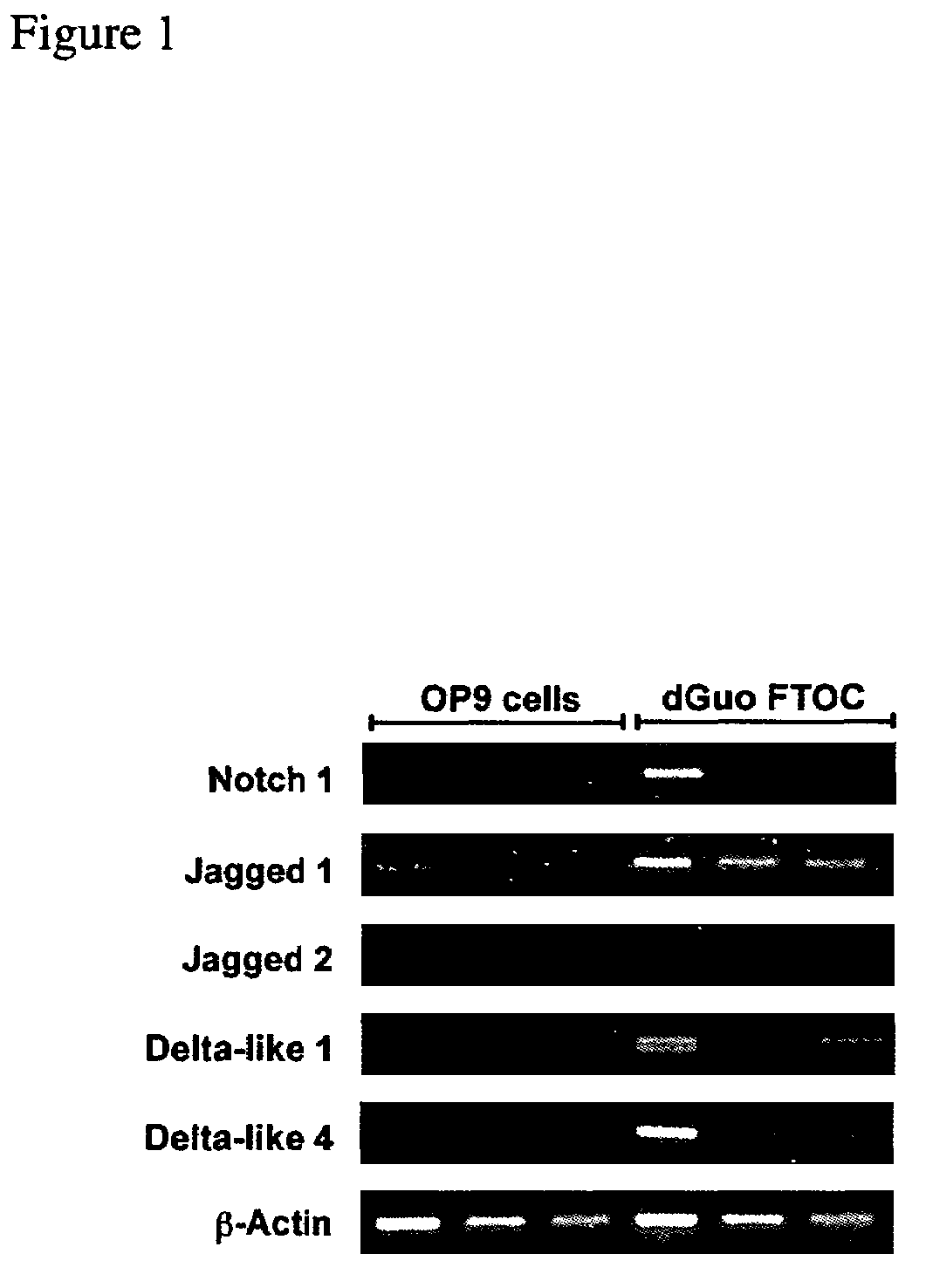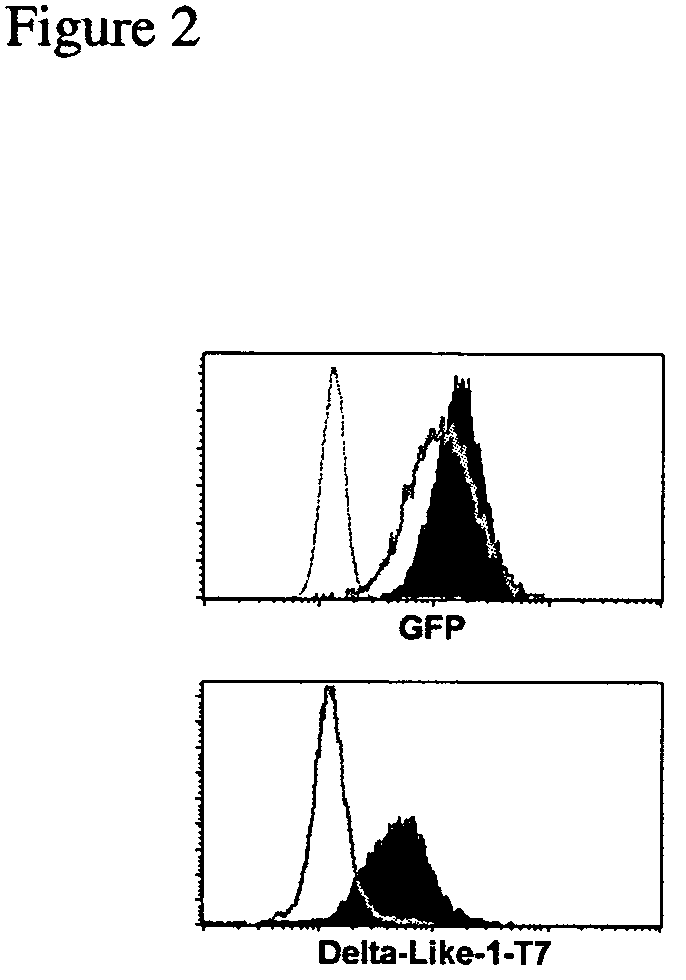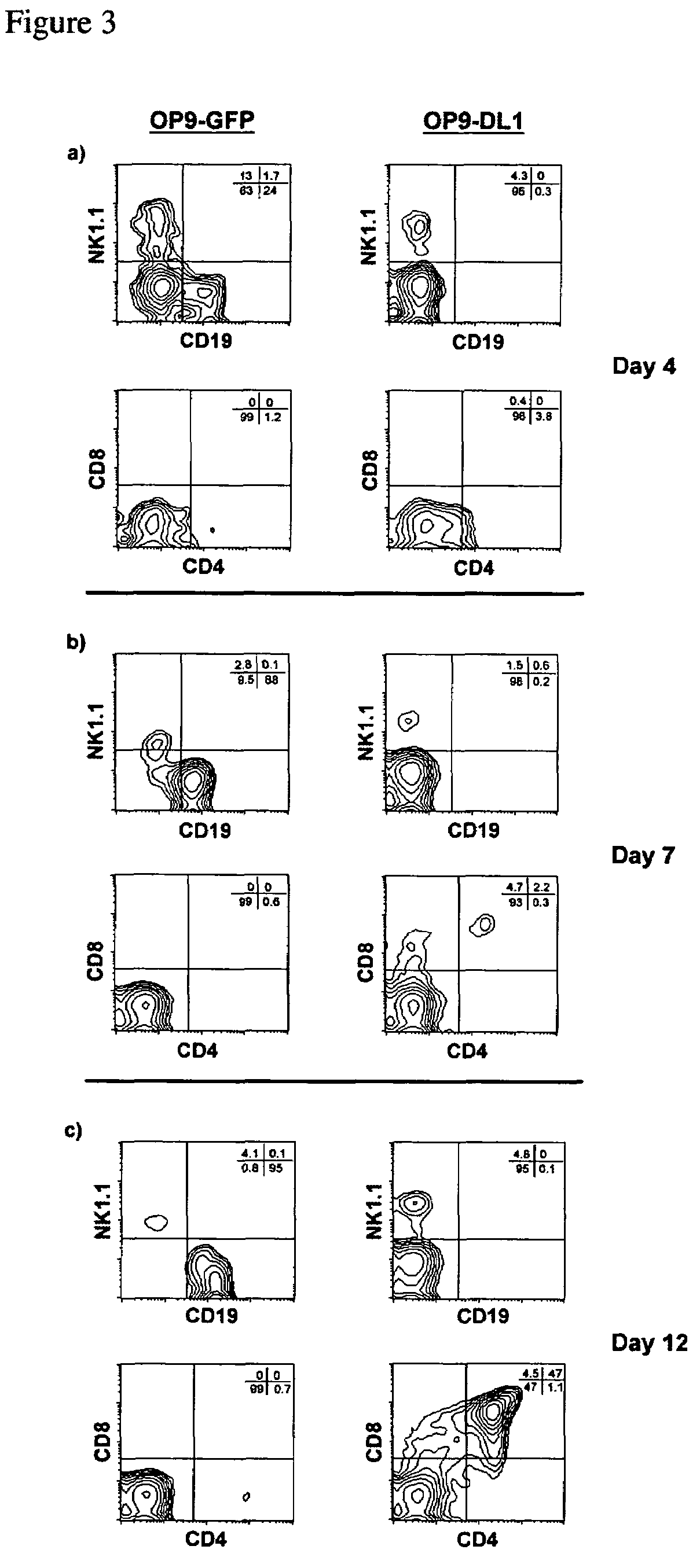Cell preparations comprising cells of the T cell lineage and methods of making and using them
a cell lineage and cell technology, applied in the field of cell preparations comprising cells of the t cell lineage, can solve the problem of not supporting b cell lymphopoiesis
- Summary
- Abstract
- Description
- Claims
- Application Information
AI Technical Summary
Problems solved by technology
Method used
Image
Examples
example 1
OP9 Cell Characterization and Expression of Notch Ligands
Experimental Procedures
[0153]Mice: Timed-pregnant Swiss. NIH mice were obtained from the National Cancer Institute, Frederick Cancer Research and Development Center (Frederick, Md.). RAG-2-deficient mice (Shinkai et al., 1992) were bred and maintained in the animal facility at the Department of Immunology, University of Toronto, Sunnybrook and Women's College Health Sciences Centre.
[0154]Flow cytometry and cell sorting: Flow cytometry was performed using a FACScalibur (BD Biosciences, San Diego, Calif.) instrument, as previously described (Carlyle and Zúñiga-Pflücker, 1998). FITC-, PE-, biotin-, and APC-conjugated mAbs and streptavidin-APC were purchased from BD Biosciences. For analysis, live cells were gated based on forward- and side-scatter, and lack of propidium iodide uptake. Intracellular staining was performed using the Cytofix / Cytoperm with GolgiStop kit according to manufacturer's instructions (BD Biosciences). Cells...
example 2
Induction of T Cell Differentiation by OP9-DL1 Cells
Experimental Procedures:
[0165]FL-HPC differentiation: HPCs were isolated from the FL of day 14 embryos by cell sorting (Sca-1hi CD117 / c-Kithi CD24low / Lin−), and placed in culture either with OP9-GFP cells, OP9-DL1 cells. Flow cytometric analysis was performed at several time points during the coculture period to determine the ability of each stromal cell line to support the differentiation of HPCs into various lymphoid lineages (FIG. 3).
[0166]ESC differentiation: The ESC line R1 were obtained from G. Caruana(Mt. Sinai Hospital, Toronto). Embryonic fibroblasts were generated from day 15-18 embryos as previously described33. Embryonic fibroblasts were cultured in ES media (DMEM, supplemented with 15% FCS, 10 U / ml penicillin, 100 μg / ml streptomycin, 100 μg / ml gentamicin, 2 mM glutamine, 110 μg / ml sodium pyruvate, 50 mM 2-mercaptoethanol, and 10 mM Hepes). ESCs were maintained by culture in ES media containing 1 ng / ml leukemia inhibito...
example 3
Induction of T-cell Differentiation by OP9-DL4 Cells.
Experimental Procedures:
[0171]FL-derived HPC differentiation on OP9-DL4 cells: HPCs were isolated from the FL of day 14 embryos by cell sorting (Sca-1hi CD117 / c-Kithi CD24low / Lin−), and placed in culture either with OP9-GFP cells, or OP9-DL4 cells. Flow cytometric analysis was performed at several time points during the coculture period to determine the ability of each stromal cell line to support the differentiation of HPCs into various lymphoid lineages.
Results
[0172]To determine whether OP9 cells expressing the Notch ligand Delta-like-4 would support the induction of T cell differentiation from FL-derived HPCs, we cultured HPCs on a monolayer of OP9 cells expressing Delta-like-4 (OP9-DL4). In keeping with our results with HPCs differentiating on OP9-DL1 cells, we did not detect CD19+B lineage cells in HPC / OP9-DL4 cocultures (FIG. 10). Rather, HPCs cultured on OP9-DL4 cells gave rise to CD4+ CD8+ immature DP T cells after 7 days ...
PUM
| Property | Measurement | Unit |
|---|---|---|
| concentration | aaaaa | aaaaa |
| density | aaaaa | aaaaa |
| density | aaaaa | aaaaa |
Abstract
Description
Claims
Application Information
 Login to View More
Login to View More - R&D
- Intellectual Property
- Life Sciences
- Materials
- Tech Scout
- Unparalleled Data Quality
- Higher Quality Content
- 60% Fewer Hallucinations
Browse by: Latest US Patents, China's latest patents, Technical Efficacy Thesaurus, Application Domain, Technology Topic, Popular Technical Reports.
© 2025 PatSnap. All rights reserved.Legal|Privacy policy|Modern Slavery Act Transparency Statement|Sitemap|About US| Contact US: help@patsnap.com



